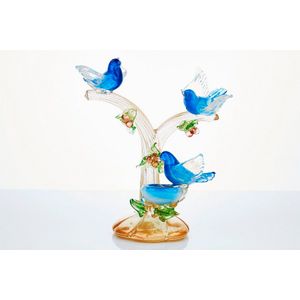Dino Martens Pitcher for Aureliano Toso, c. 1950
You must be a subscriber, and be logged in to view price and dealer details.
Subscribe Now to view actual auction price for this item
When you subscribe, you have the option of setting the currency in which to display prices to $Au, $US, $NZ or Stg.
- Ewer / Pitcher - A type of jug with a narrow neck bulbous body and wide spout, originally used for carrying and storing liquids such as water or wine. In medieval times they were the source of water to wash ones hands during and after a meal. later the shape was used for vessels in silver, gold, glass and ceramics.
In Victorian times they were made in ceramics and occasionally glass with a matching basin, and sometimes other accessories such as a soap holder or toothbrush holder. Their purpose was to provide facilities for personal washing In the early 19th century were often enclosed in purpose built stands, and later resided on a washstand..
Sometimes the words "ewer" and "pitcher" are used interchangably, but a pitcher is generally considered to be a jug, and would have a wide mouth, and a gently tapering body. - Filigrana - In glassmaking, filigrana involves fusing fine threads of coloured glass into clear glass to create intricate patterns. This can be done using a variety of techniques, including blowing, moulding, or casting. The result is a glass object with delicate, intricate designs that have a subtle and elegant appearance.
- Inclusions - Inclusions in glass objects refer to small, often irregularly shaped particles or bubbles that are trapped within the glass during the manufacturing process. These inclusions can be intentional or unintentional, and can range in size, shape, and composition.
Intentional inclusions are often added to the glass for decorative purposes, and can include materials such as colored glass, metallic foils, or even small mementos like photographs or other objects. These intentional inclusions are typically added to the glass while it is still in a molten or semi-molten state and are then moulded or blown into the final shape of the object.
Unintentional inclusions, on the other hand, are typically the result of impurities or air bubbles that become trapped within the glass during the manufacturing process. These inclusions can be seen as small specks or bubbles within the glass, and can sometimes be a sign of poor quality control during production.
While intentional inclusions can be a desirable feature of some glass objects, unintentional inclusions can sometimes be seen as a defect, and can reduce the value of a piece. However, in some cases, certain types of unintentional inclusions can actually increase the value of a piece, such as with antique glass that contains bubbles or other imperfections that are characteristic of the time period in which it was made.
This item has been included into following indexes:
Visually similar items

After Alfredo Barbini, Murano glass sculpture, depicting three blue love birds on a tree infused with gold aventurine, height 35 cm

A pair of Lalique glass book-ends, in the form of doves. (a/f) height 16 cm

An Orrefors glass bowl with vertical fluting. 23 cm wide. Together with a Lalique glass vase of flared form, with a number of large chips. 28 cm high

Lalique 'Coquet' & 'Colereux' figures. Lalique 'Coquet' & 'Coléreux' figures signed 'Lalique France' with original ?Made in France' stickers to the base. Length of largest 13.5 cm
